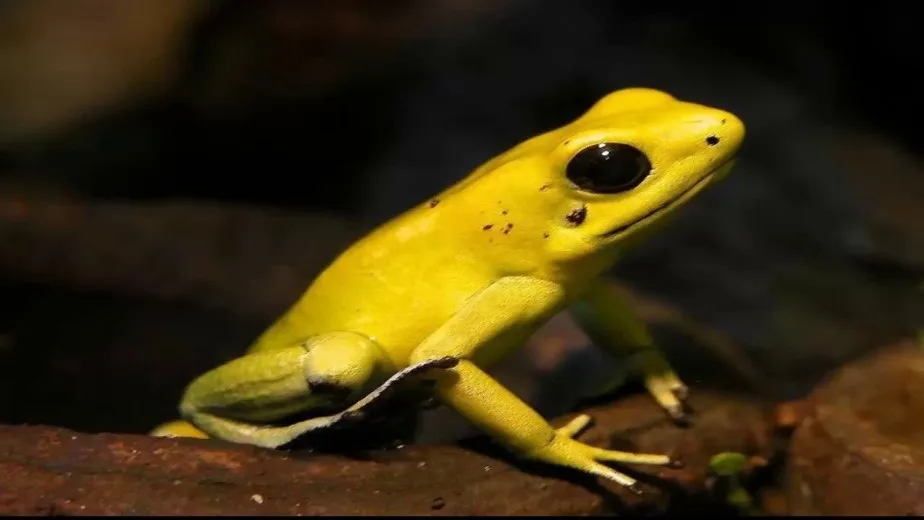The Amazon rainforest is an awe-inspiring place, full of life and mystery. However, the most dangerous animals of the Amazon can take us by surprise. In this humid jungle, there are species that are so strong or venomous that, even though they avoid human contact, they can pose a real threat. In this article, we will explore the dangerous wildlife of the Amazon, describing each animal (its habitat and the countries where it lives) and explaining why it is so feared. Here, you’ll discover why these Amazonian predators and insects are lethal creatures and what precautions you should take.
1. Jaguar (Panthera onca)
The jaguar is the largest feline in the Americas and one of the most dangerous animals of the Amazon. It is widely distributed across countries such as Brazil, Peru, Bolivia, Colombia, and Venezuela. It prefers habitats near rivers and lakes, from tropical rainforests to swamps.
Thanks to its powerful jaws, it can crush the skulls of its prey and hunt large animals like deer, peccaries, and capybaras. Although it rarely attacks humans, its stealth and strength make it one of the most feared predators in the Amazon jungle. The jaguar is also a cultural symbol in many Amazonian indigenous communities.
Additionally, the jaguar has the strongest bite of any feline, relative to its size. This allows it to pierce turtle shells or even crack dense bones, making it unique among large carnivores. It is nocturnal and solitary, relying on a keen sense of smell and sight to hunt.

2. Green anaconda (Eunectes murinus)
The green anaconda is the heaviest snake in the world and one of the most dangerous animals of the Amazon. It can exceed 6 meters (20 feet) in length and weigh over 200 kg (440 lbs). It lives in slow-moving waters, swamps, and flooded forests across the northern regions of South America, including the Amazon Basin.
Although non-venomous, it kills its prey by constriction, wrapping it in its muscular coils. It feeds on large rodents, deer, birds, caimans, and even young jaguars. Its brute strength makes it dangerous if threatened, and in some areas, it has been reported attacking livestock near human settlements.
Anacondas are ovoviviparous, meaning they give birth to live young instead of laying eggs. A single female can produce between 20 and 40 fully formed offspring. They are excellent swimmers, capable of remaining submerged for long periods while waiting to ambush.
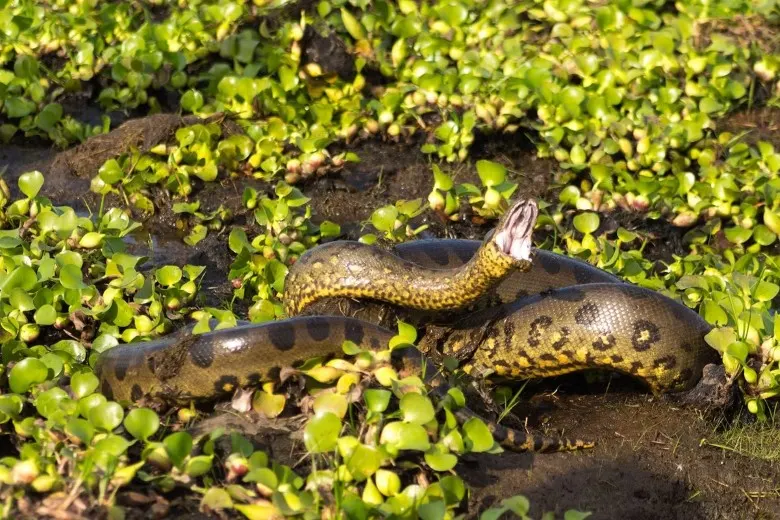
3. Amazonian scorpions (Tityus genus)
Scorpions of the Tityus genus are highly venomous and inhabit tropical forests of the Amazon. One of the most dangerous is the Amazonian black scorpion (Tityus obscurus), considered among the most dangerous animals of the Amazon due to its lethal venom. They are nocturnal and hide under rocks, bark, or leaf litter.
Its venom is a powerful neurotoxin that can cause intense pain, vomiting, heart disturbances, and even death, especially in children and vulnerable adults. Stings from these species require urgent medical attention and are among the most dangerous of Amazonian arachnids.
Besides their danger, Tityus scorpions are highly resilient and adaptable, capable of surviving in degraded environments, including deforested rural areas. Their activity increases during the rainy season, when they seek dry refuge, sometimes even inside homes.
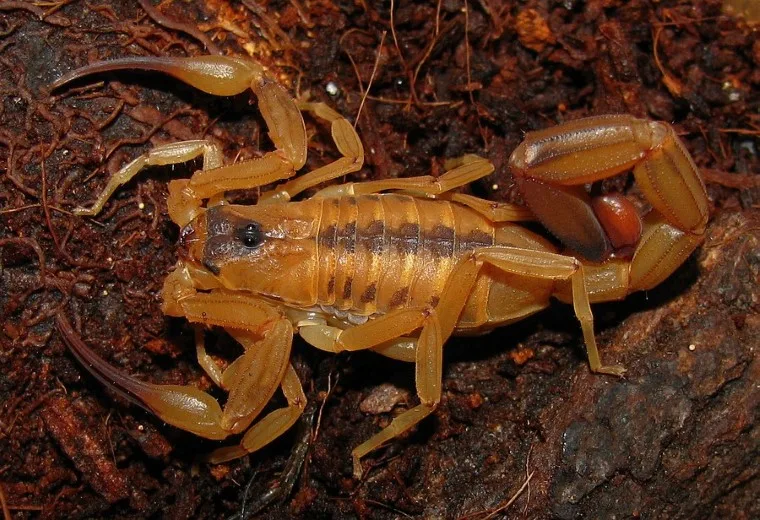
4. Brazilian wandering spider (Phoneutria genus)
Known as the wandering spider or “banana spider,” this species lives in several Amazonian countries. It is considered one of the most venomous spiders in the world, and without a doubt, one of the most dangerous animals of the Amazon. It does not spin webs, but instead walks the forest floor and vegetation at night in search of prey.
Its venom can cause severe pain, paralysis, and in severe cases, death, especially if antivenom is not administered in time. Though it may not look intimidating, it is responsible for many serious medical incidents in the Amazon region.
There are reports of these spiders hiding in fruits (especially bananas), hence their nickname. They are very aggressive: when threatened, they raise their front legs and show their fangs in a defensive posture.

5. Bullet ant (Paraponera clavata)
Nearly 3 cm (1.2 inches) long, this ant earned the name “bullet” because its sting causes pain comparable to being shot. The pain can last between 12 and 36 hours, with symptoms like fever, chills, and sweating.
It inhabits dense tropical forests, building nests at the base of trees. While its venom is not typically lethal, its intense pain has made it part of initiation rituals in some Amazonian tribes. It is one of the continent’s most feared insects and unquestionably one of the most dangerous animals of the Amazon.
The venom contains poneratoxin, a neurotoxin that affects the central nervous system. In rituals among tribes such as the Sateré-Mawé of Brazil, young men must endure multiple stings as a test of courage and endurance.
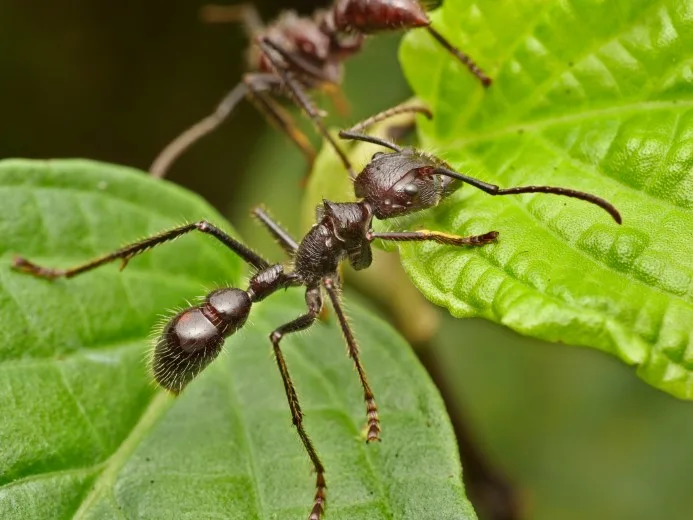
6. Candirú (Vandellia cirrhosa)
This tiny parasitic fish is feared for its unusual behavior. It lives in the rivers and tributaries of the Amazon, and normally feeds on the blood of other fish, entering through the gills.
There are legends—and some documented cases—of it entering the human urethra, getting stuck with its spines and requiring surgical removal. While such incidents are extremely rare, its ability to invade the human body makes it one of the scariest fish in the Amazon, and certainly one of the most dangerous animals of the Amazon.
The candirú is blind and tracks compounds like urea in the water, which explains why it may be attracted to human urine. It is slender, translucent, and measures between 2 to 6 cm, making it nearly invisible to the eye.

7. Black caiman (Melanosuchus niger)
The black caiman is the largest reptile in the Amazon, reaching up to 6 meters (20 feet) in length. It lives in rivers, lakes, and swamps, and is an apex predator. It hunts animals like peccaries, monkeys, birds, capybaras, and even young anacondas.
Its jaws are incredibly powerful, able to crush bones with ease. Although it rarely attacks humans unless provoked, its territorial nature makes it a potential threat in fishing or boating areas. For these reasons, it is classified among the most dangerous animals of the Amazon.
The black caiman was once endangered due to heavy hunting for its leather, but its populations are now recovering, though still vulnerable. It is a nocturnal hunter and skilled ambusher.
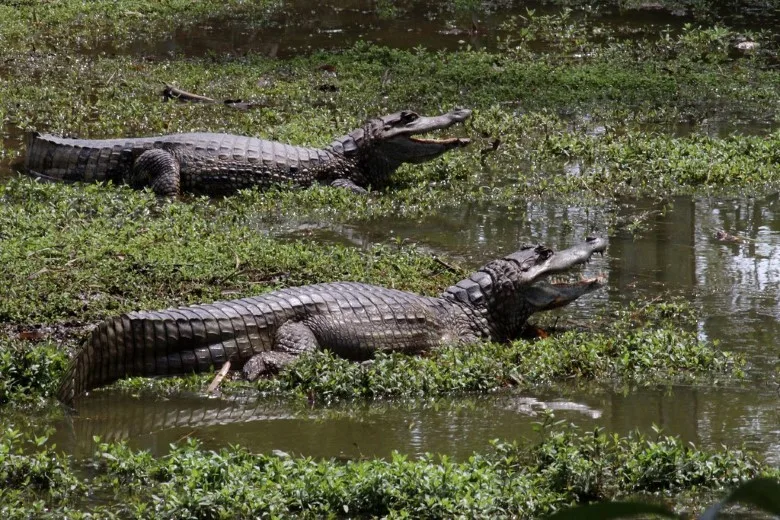
8. Anopheles darlingi mosquito
This mosquito is the main vector of malaria in the Amazon. The danger lies not in the bite itself, but in the parasites it transmits, which cause high fever, anemia, and potentially death.
It lives in humid areas with stagnant water. It is the deadliest insect in the rainforest, causing thousands of malaria infections every year. Using repellent, protective clothing, and mosquito nets is essential. Its massive public health impact clearly makes it one of the most dangerous animals of the Amazon.
Besides malaria, it can also transmit diseases such as yellow fever, dengue, and the Mayaro virus. It is most active at dawn and dusk, requiring extra precautions during those hours.
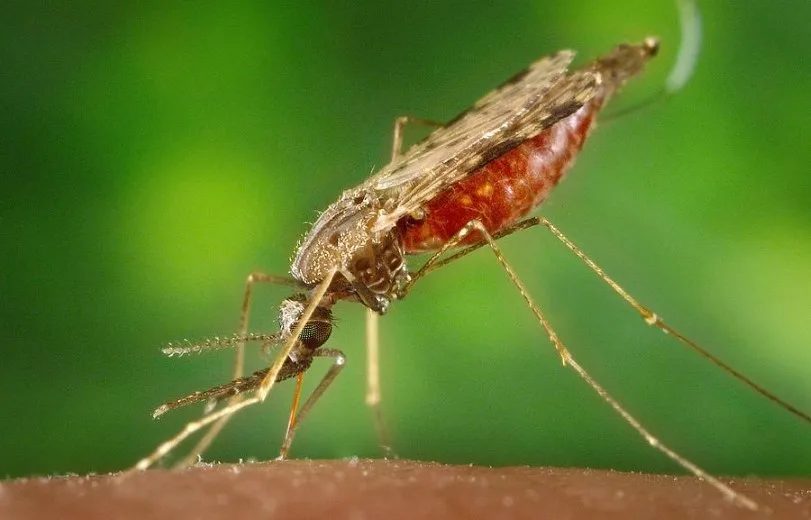
9. Fer-de-lance (Bothrops atrox)
This pit viper is one of the most common and dangerous snakes in the Amazon. It blends with the leaf litter on the forest floor, making it a real danger for anyone walking carelessly.
Its venom is hemotoxic, destroying tissues, causing internal bleeding, and possibly organ failure. Its strike is fast and aggressive, and requires immediate medical attention. It accounts for a large portion of serious snakebite cases in the region and is undoubtedly one of the most dangerous animals of the Amazon.
It is territorial and aggressive, especially during the rainy season. It may deliver multiple bites if cornered. It is responsible for up to 50% of snakebite envenomings in many tropical regions of South America.
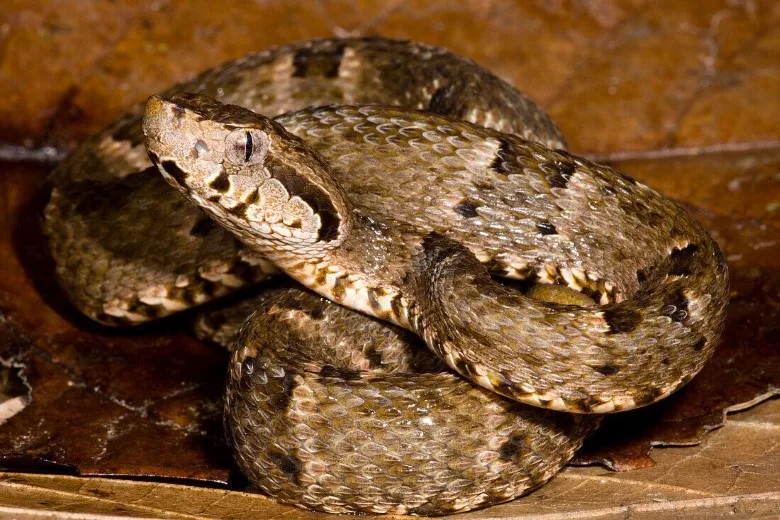
10. Poison dart frog (Phyllobates terribilis and others)
Despite being only 2 to 6 cm long, these brightly colored frogs store one of the most powerful toxins in the animal kingdom: batrachotoxin. A small amount can kill up to 10 adults if it enters wounds or mucous membranes.
They are used by indigenous people to poison the tips of their darts and arrows. Although some species are more common in Colombia, they also appear in nearby Amazonian areas. They are a striking example of biological danger in harmless appearance, and clearly part of the most dangerous animals of the Amazon.
The frogs’ toxins come from their wild diet, especially insects rich in alkaloids. In captivity, they lose their toxicity, showing the link between ecology and venom production.

11. Red-bellied piranha (Pygocentrus nattereri)
This carnivorous piranha, reaching up to 30 cm (12 inches) long, lives in Amazonian rivers in Brazil, Bolivia, Colombia, Venezuela, and other countries. It hunts in schools and is famous for its sharp triangular teeth and strong bite.
Although mass attacks on humans are rare, they can cause serious injuries when water levels are low or food is scarce. They also attack sick or injured animals. Due to their aggression, they are among the most feared fish and one of the most dangerous animals of the Amazon.
They detect blood traces and water vibrations from a distance. Their jaws can shred flesh and bone in seconds, and they have a highly developed sense of smell that makes them very efficient hunters.

12. Electric eel (Electrophorus electricus)
This fish, similar to an eel, lives in murky waters and slow-moving rivers of the Amazon. It produces electric shocks of up to 600 volts, which it uses to hunt or defend itself. It can immobilize large prey and cause momentary paralysis.
Though not aggressive by nature, it can be fatal if the shock occurs in deep water, causing drowning. Its unique defense mechanism makes it one of the most fascinating and dangerous predators in the aquatic ecosystem, and undoubtedly one of the most dangerous animals of the Amazon.
It has specialized electric organs that occupy up to 80% of its body, and it can release multiple bursts of electricity, generating electric fields for navigation and communication.
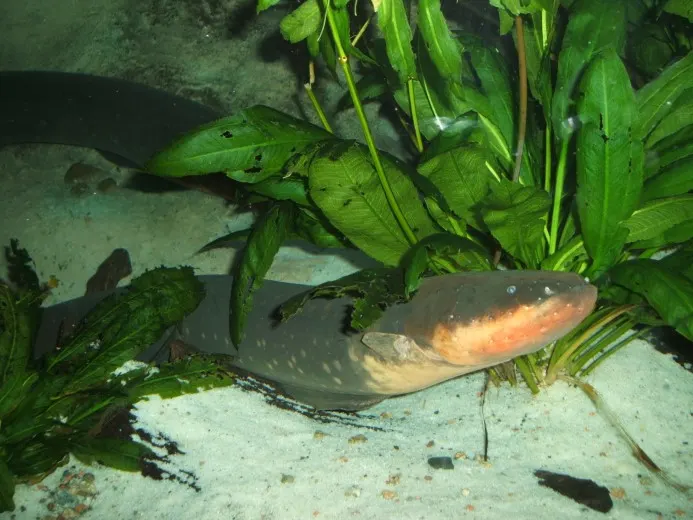
13. Tarantula hawk wasp (Pepsis spp.)
These tarantula-hunting wasps are impressive both for their size (up to 7 cm) and their stinger up to 12 mm long. They live in tropical forests throughout Latin America, including the Amazon.
Their sting is extremely painful, considered one of the most painful in the animal kingdom (Schmidt Index 4). While not fatal, it causes sharp pain, temporary paralysis, and intense discomfort. Best to stay away from these giants, as they are among the most dangerous animals of the Amazon.
They hunt tarantulas to feed their larvae, paralyzing the spider with venom and laying an egg inside its body. The larva feeds on the host while it is still alive. Despite their terrifying appearance, they don’t attack unless provoked.
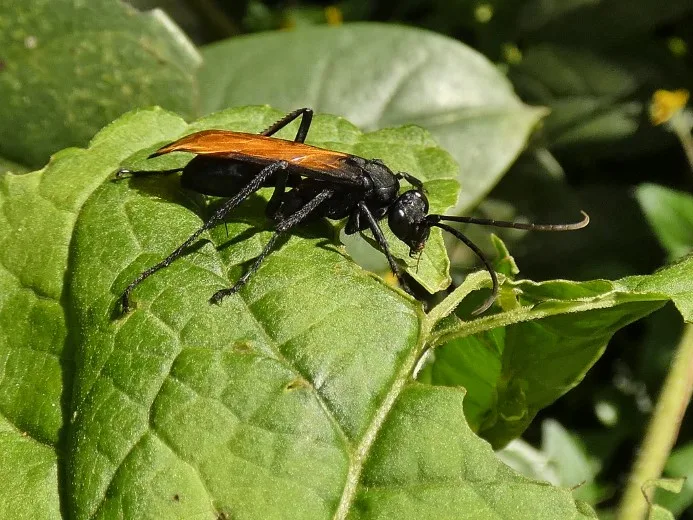
Frequently Asked Questions about the Most Dangerous Animals of the Amazon
1. What is the most dangerous animal in the Amazon?
There isn’t a single answer. It depends on what we mean by “dangerous.” The jaguar is the most feared big cat due to its strength, while the golden dart frog has one of the most lethal toxins in the world.
Mosquitoes like Anopheles darlingi kill more people indirectly by transmitting malaria. In short, the most dangerous animals of the Amazon include large predators, venomous snakes, and deadly insects. Each one is the “most dangerous” in its category: land predator, fish, insect, or reptile.
2. What should I do to avoid danger in the Amazon jungle?
If you’re traveling to the Amazon, learn about basic precautions beforehand.
For example:
- Wear clothing that covers your skin to reduce mosquito bites (malaria and other diseases).
- Don’t put your hands where you can’t see clearly, to avoid contact with bullet ants or scorpions.
- Avoid swimming alone in areas where there may be caimans or piranhas.
- Bring a basic medical kit with local antivenom, if possible.
In general, respect the jungle: many animals attack out of self-defense.
Keep your distance from any animal, especially those that look venomous (bright colors, fangs, stingers).
If you encounter a jaguar or a caiman, it’s best to back away slowly; these animals usually avoid humans when they can.
Remember: dangerous Amazonian wildlife doesn’t seek confrontation with you, and an unexpected encounter usually ends with the animal fleeing.
3. Which Amazon insects are the deadliest to humans?
The most dangerous insects don’t usually kill instantly, but through diseases.
The Anopheles mosquito is the deadliest, as it transmits malaria, a potentially fatal disease.
There are also mosquitoes that transmit dengue and Zika.
Among the insects that cause extreme pain are:
- The Pepsis wasp
- The bullet ant
Others, like venomous scorpions and spiders, are less common, but their neurotoxic venom can be very dangerous.
Always apply repellent and check your surroundings at dusk.
4. What snakes in the Amazon should I avoid?
Besides the fer-de-lance (Bothrops atrox), there are other venomous snakes in the jungle, such as:
- The yarará (also Bothrops atrox)
- The true coral snake (Micrurus spp.)
- The Amazonian rattlesnake (Crotalus durissus)
All of them can inject deadly venom.
There are also large non-venomous snakes, such as the anaconda, which can be dangerous if they feel threatened.
In short, any snake in the jungle deserves respect and distance.
In case of a bite, it is crucial to stay calm, immobilize the affected limb, and seek urgent medical attention.
5. Do Amazon animals often attack humans?
Most animals do not seek to attack people.
However, risks do exist:
- A mosquito can bite you while you sleep and transmit malaria.
- Large predators, such as jaguars and caimans, rarely hunt people, but will defend their territory if you get too close.
- Animals like piranhas or electric eels may attack out of confusion or self-defense, for example, when the riverbank is disturbed.
Dangers in the Amazon often happen by surprise or recklessness. That’s why learning about local wildlife and following the advice of expert guides is essential to avoid fatal encounters.
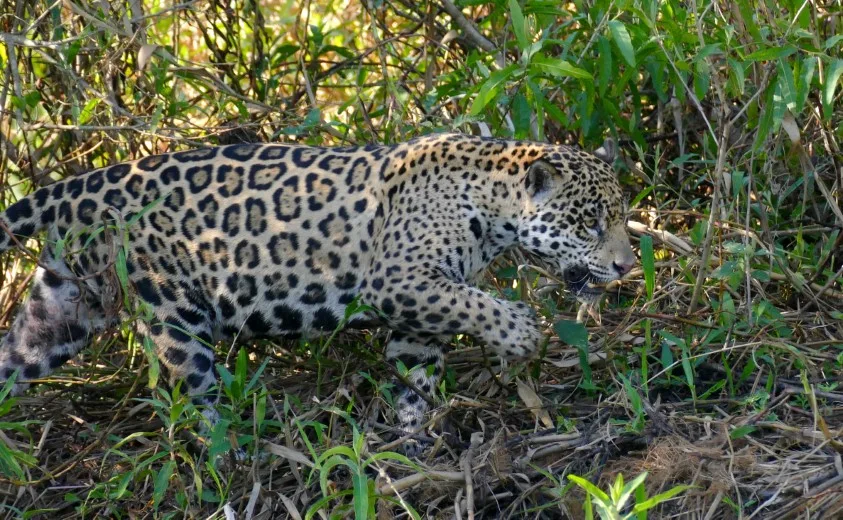
Explore the Peruvian Amazon and discover some of the most exotic animals in Peru in their natural habitat. With Peru Jungle Trips, you can enjoy an authentic and safe experience in the jungle, accompanied by expert guides who will show you the incredible biodiversity of one of the planet’s most fascinating places.

